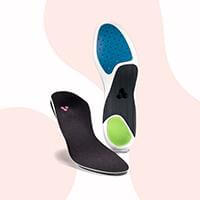Arch Tendonitis
When you wear insoles from Align Footwear®, you not only address the symptoms, you also prevent the very causes of insufficient arch mobility.
If, during exercise, you often feel pain concentrated around the arch and arch tendon, every step you take will pull on the arch tendon, which spans the heel bone and all five toes on the front of your foot.

What is arch tendonitis?
Underneath your foot, the arch tendon runs from the front edge of the heel bone and spreads like a fan as far as the toes. Arch Tendinitis is irritation in the tack on the heel bone, which can lead to calcification of the tendon. The tendon becomes more rigid than normal. A rigid tendon can cause ruptures that, in turn, can cause pain during activity.
Arch tendonitis is one of the major causes of pain in your heels. It is important to take the first signs very seriously as tendon problems tend to become prolonged if ignored. If you feel tenderness in your arches, you should stop and avoid activities that provoke this type of soreness or pain. It is important that you find the cause or causes of your pain.
What causes arch pain?
- Flat foot and excessive pronation when walking, jumping or running
- Sudden increase in duration, distance or a switch to a hard surface during exercise
- Excessively high arches
- Wearing shoes that do not fit your medial arch or that have inadequate shock absorption
- Overweight
In the vast majority of cases, arch pain is due to overloading the tendon at the heel bone. Repeated overload when jumping and running as well as long periods of standing (especially on hard surfaces) can cause severe pain in the arch. You risk developing arch tendonitis when you stand for long periods on hard surfaces and/or play sports that include a great deal of jumping. Flat foot may also increase the risk.
Wearing ill-fitting shoes can also cause a lot of pain. For example, wearing shoes with a high arch support when you have a low arch or are flat-footed can cause severe arch pain when you run. Arch tendinitis develops gradually and is often experienced as slowly increasing soreness at the front of the heel pad and a little towards the inside of the foot. Soreness is usually triggered by walking, jumping or running – and when you step down on the foot. Finally, pain may also be experienced as early morning stiffness and soreness. Once the muscles of the foot are mobile and warm, the pain subsides.
Treatment of arch tendonitis
Ask your GP or physiotherapist for pain-relieving exercises. When you resume running, take it easy, slowly and gradually increasing distance and intensity. It is, of course, imperative that your footwear is in order, i.e. that you have good running shoes with a shock-absorbing heel. If you feel you are not making progress despite slow rehabilitation, medical treatment with anti-arthritis medication or corticosteroid injections might be considered.
If you react fast when the symptoms appear and take steps to relieve the arch and heel by desisting from pain-triggering activity, arch tendonitis will often disappear after a short time. However, if you ignore the signals and the tendon thickens, you risk a long period of rehabilitation.
Ask a physiotherapist to perform a scan to detect tendonitis. Arch tendonitis is treated with stretching and other soft tissue treatment. In case of active inflammation, the solution might be an injection with corticosteroids in order to reduce inflammation. If tendonitis is related to misalignment of the foot when walking or running, you should wear footwear that provides adequate support. Good shock absorption is very important. A physiotherapist or chiropodist can guide you and assess whether you need corrective footwear, etc. Furthermore, pads and arch supports may be an effective and sustainable solution.
What can you do?
Seek professional advice and stretching exercises. Contact your physiotherapist, family doctor or podiatrist. They can work wonders. They can help you to find appropriate footwear/shoes.
What can Align Footwear® do?
We believe that Align Footwear® insoles can help by aligning your body. A study by Runner’s World’s third-party expert, Dr. Martyn Shorten PhD, found that Align Footwear® insoles align the ankle into a more neutral position by up to 32%, decrease pronation by up to 27%, and align the tibia (shinbone) into a more neutral position by up to 40%. When you provide these levels of correction, you improve biomechanical alignment through your entire kinetic chain, increase efficiency and minimise repetitive stress that would otherwise have to be absorbed by your soft tissue, joints, tendons and ligaments. Align Footwear® insoles help align your body and relieve pain.
By supporting the foot, we retain the full mobility in our muscles and tendons, which we cannot achieve if we just build a support under the foot or incorporate a compression pad or an “artificial” arch support. By wearing the internationally patented tri-planar points in Align Footwear® insoles, we achieve comfort and well-being due to a more evenly distributed body weight and more balanced load on the feet.
Align Footwear® insoles enhance movement, comfort and performance. They promote better posture and body alignment in your kinetic chain and improve your health and well-being. When your body is aligned and you move correctly, i.e. in the natural position, the load of every step you take is more evenly distributed. Our insoles reduce destructive shock waves throughout your body every time your feet hit the ground. This makes for less pressure and less potential inflammation of the joints, muscles, tendons and ligaments.

60-day Refund Policy
Full satisfaction or money back

You didn’t find an answer?
Call +45 22 633 633
or contact@alignfootwear.eu


